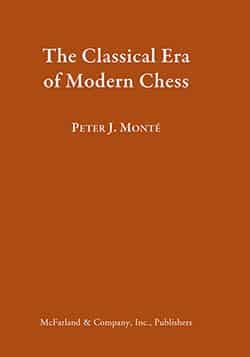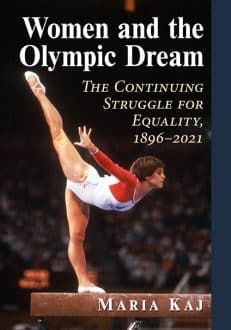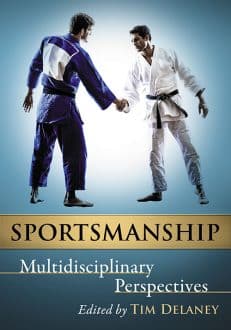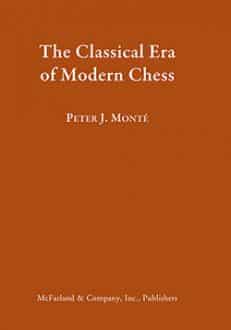The Classical Era of Modern Chess
Original price was: $75.00.$49.95Current price is: $49.95.
In stock
About the Book
First introduced by Arabs to newly gained territories in the Mediterranean during the 8th and 9th centuries, the game of chess soon spread throughout Europe, slowly evolving from the less dynamic shatranj version into modern chess. This study examines the classical era of what became modern chess from the late 15th century into the 1640s, paying special attention to key developments in the medieval period and later. After tracing the birth of modern chess in Europe, it offers a critical appreciation of relevant chess literature—including works by von der Lasa, van der Linde, Murray, Chicco, Eales, Petzold, Sanvito, Garzón and many others—and chronicles all openings and games of the era and the long drawn-out development of laws and rules like “en passant” taking and castlings. At 616 pages, with a glossary, appendices, bibliography, an exhaustive index and more than 150 illustrations, this is the definitive overview of a transformative era in the history of chess.
About the Author(s)
Bibliographic Details
Peter J. Monté
Format: library binding (7 x 10)
Pages: 616
Bibliographic Info: 155 illustrations, glossary, appendices, bibliography, index
Copyright Date: 2014
pISBN: 978-0-7864-6688-7
Imprint: McFarland
Table of Contents
List of Illustrations xi
Acknowledgments xiv
Preface xv
Abbreviations xix
Glossary xxi
Part I—The History of Early Modern Chess
Introduction 1
The diffusion of shatranj 3
Medieval chess 14
The birth of modern chess 19
Chapter 1. The First Sources 25
A. Scachs d’amor 26
B. Le Jeu des Eschés de la Dame, Moralisé 31
Chapter 2. Lucena 33
Rules 36
Openings 37
The Problem Section 39
The Background of Lucena’s Life 65
Dating Lucena’s Book 67
Chapter 3. The Lucena Manuscript 69
Rules 70
Openings 71
Conclusion 73
Chapter 4. The Göttingen Manuscript 74
Date and Origin 76
Rules 79
Openings 79
Comparing Three Sources 82
Conclusion 83
Chapter 5. Damiano 85
Rules 87
Openings 88
Subtleties and Problems 89
Reprints 100
Gruget and Rowbothum 105
White’s Damiano 108
Conclusion 116
Chapter 6. The German Manuscript 117
Rules 118
Openings 118
Subtleties and Problems 120
Conclusion 122
Chapter 7. Ruy López 124
Visiting Rome 127
Rules 129
Openings 133
Italians on Iberian Soil 136
Conclusion 145
The López-Complex 146
Chapter 8. The Urbinate Manuscript 147
Rules 148
Openings 150
A Spanish and an Italian Author 152
Conclusion 154
Chapter 9. The “Elegance” Manuscripts 156
A. The Elegantia 156
B. The Regole 159
C. The Riccardiana 160
D. Comparing the Documents 163
Rules 163
Openings 166
The Elegantia and the Regole 170
The Italian Manuscripts and the Riccardiana 171
Conclusion 172
Chapter 10. Printed Works of the López-Complex 175
A. Tarsia 175
B. French López-Editions 178
C. Selenus 180
Chapter 11. Annibale Romei 188
Rules 190
Openings 191
Subtleties 192
Conclusion 193
Chapter 12. Polerio’s Boncompagno Manuscript No. 1 194
Rules 197
Openings 199
Comparing Other Manuscripts 202
Ascriptions 203
Spanish and Neapolitan Features 215
The Problems 217
Conclusion 219
Chapter 13. Polerio’s Leon Manuscript 222
Rules 222
Openings 223
Contemporaries 226
Conclusion 227
Chapter 14. Polerio’s Boncompagno Manuscript No. 2 228
Dedication 230
Rules 231
Openings 232
Subtleties and Problems 238
Conclusion 242
Chapter 15. Rotilio Gracco 244
Dedication 246
Poetry 246
Rules 247
Openings 248
Conclusion 248
Chapter 16. Polerio’s Ordini Manuscript 250
Dedication 251
Rules 253
Openings 254
The Problem Section 255
Conclusion 257
Chapter 17. Anonymous Works of the Polerio-Complex 260
A. The Doazan Manuscript 260
Transcriptions 260Table of Contents
261
Rules 264
Openings 265
The Problem Section 268
Contemporaries 269
Conclusion 271
B. The Boncompagno Manuscript No. 3 274
Rules 275
Openings 275
An Ending 277
Conclusion 277
Chapter 18. Horatio Gianutio 278
Rules 280
Openings 283
The Problem Section 284
Conclusion 286
Chapter 19. Alessandro Salvio 288
His Life 288
The “Trattato” (1604) 289
La Scaccaide (1612) 291
“Il Puttino,” “Apologia” and “Seconda Impressione” (1634) 292
Rules 293
Openings 294
Problems and Endings 295
Conclusion 300
Chapter 20. Pietro Carrera 301
His Life 301
His Chess Work 302
Rules 307
Openings 307
Problems and Endings 308
Vespaio’s “Risposta” 314
Conclusion 316
Chapter 21. Gioacchino Greco 318
His Life 318
The Manuscripts 321
Greco’s Sources 341
Presenting Greco’s Writings 344
Rules 347
Openings 348
Problems and Endings 350
Conclusion 354
Chapter 22. The Pawn’s Leap 355
Passar Battaglia 358
Taking En Passant 361
Conclusion 369
Chapter 23. From the King’s
Leap to Castling 371
The King’s Leap 371
Castling 387
Conclusion 410
Epilogue 416
Evaluation 416
Miscellanies 417
Aftermath of the Classical Era 428
Part II—Openings and Games of the Classical Era of Modern Chess 439
Part III—Appendices, Bibliography, Index 531
Appendix A. Problem Sections 531
i. Lucena’s problem section 531
ii. Concordance of Problem Sections 540
Appendix B. Concordance of the Lucena-Complex 546
Appendix C. Concordance of the López-Complex 549
Appendix D. Concordance of the Polerio-Complex 552
i. Openings 552
ii. Ascriptions 561
Bibliography 567
Index 577
Book Reviews & Awards
- Honorable Mention, Book of the Year Award—Chess Journalists of America
- “One of the most important chess books published in the last twenty years…highly recommended”— IM John Donaldson (JeremySilman.com)
- “Like Murray’s great work on the History of Chess, it will stand the test of time and will, due to its prodigious scholarship, eventually always be mentioned along with that previous classic…the erudition, the care, and the enormous effort which went into it is obvious. It deserves a warm reception”—Dale Brandreth, Caissa Editions
- “Monté delivers great research and his brilliant, exhaustive work is unique in chess history. But the most amazing part are the openings and games of the period…an absolute must”—Huffington Post





